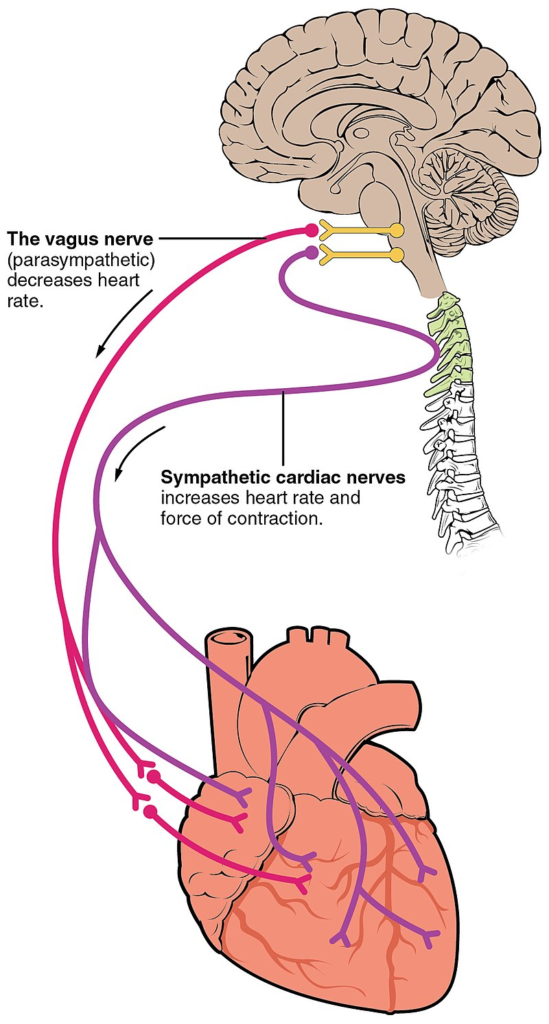Regulation of Heartbeat: The heartbeat is regulated by the autonomic nervous system (ANS), which maintains the balance between sympathetic and parasympathetic influences on the heart. This balance ensures that the heart rate and rhythm meet the body’s immediate needs, whether it’s the “fight or flight” response or the “rest and digest” state. Here’s a detailed note on how the autonomic nervous system regulates the heartbeat:

Regulation of Heartbeat
1. Components of the Autonomic Nervous System:
The autonomic nervous system consists of two main divisions:
a. Sympathetic Nervous System: Commonly referred to as the “fight or flight” system, the SNS becomes active during stressful situations, physical exertion, fear, or excitement. It prepares the body for rapid action by stimulating the heart to beat faster and more forcefully. The neurotransmitter released is norepinephrine (noradrenaline), which binds to beta-adrenergic receptors in the heart. This stimulation increases the heart rate (positive chronotropy) and contractility (positive inotropy) to meet the body’s heightened oxygen and energy demands.
b. Parasympathetic Nervous System: Known as the “rest and digest” system, the PNS dominates during periods of calm and recovery. It promotes a state of relaxation by slowing down the heart rate and reducing cardiac workload. The main neurotransmitter is acetylcholine, which acts primarily via the vagus nerve (cranial nerve X). Acetylcholine decreases the rate at which the SA node fires, thus slowing the heart rate (negative chronotropy) and promoting energy conservation.
2. Role in Heartbeat Regulation
The sinoatrial (SA) node, located in the right atrium, serves as the natural pacemaker of the heart. It spontaneously generates electrical signals that initiate each heartbeat. The ANS modulates the activity of the SA node, not by creating signals, but by increasing or decreasing the rate at which these impulses are generated. This allows the heart to rapidly adjust its rhythm in response to internal and external stimuli like exercise, stress, sleep, and emotional states.
3. Sympathetic Regulation
When the body is under stress or in an active state:
The sympathetic nervous system becomes dominant and releases norepinephrine from sympathetic nerve endings. Norepinephrine binds to beta-1 adrenergic receptors on the SA node and other parts of the heart. This leads to faster depolarization, resulting in an increased heart rate and stronger ventricular contractions. Consequently, cardiac output rises, enhancing blood supply to muscles and vital organs—essential for the body to perform during emergencies or physical activity.
4. Parasympathetic Regulation
During periods of rest and digestion:
The parasympathetic nervous system predominates and releases acetylcholine through the vagus nerve. Acetylcholine binds to muscarinic receptors on the SA node, leading to slower depolarization. This reduces the firing rate of the SA node, resulting in a slower heart rate and decreased cardiac output. This effect is vital for recovery, promoting healing, digestion, and conservation of energy.
5. Baroreceptors
Baroreceptors are pressure-sensitive receptors located primarily in the carotid sinuses and aortic arch. They detect changes in blood pressure and send signals to the brainstem, which adjusts autonomic outflow accordingly. When blood pressure increases, baroreceptors stimulate the parasympathetic system to slow the heart rate. Conversely, when blood pressure drops, they activate the sympathetic system to raise the heart rate and enhance cardiac output. This baroreceptor reflex is essential for moment-to-moment regulation of blood pressure and heart function.
6. Hormonal Regulation
In addition to direct nerve signals, hormones released into the bloodstream also influence heart activity:
The adrenal medulla secretes epinephrine (adrenaline) and norepinephrine during stress or emergency responses. These hormones mimic the effects of sympathetic stimulation by binding to adrenergic receptors on the heart. This results in increased heart rate, stronger contractions, and improved blood delivery to muscles and organs.
7. Resting heart rate
At rest, the parasympathetic nervous system has a dominant influence over the heart:
This maintains a lower resting heart rate, usually between 60–80 beats per minute in healthy adults. Athletes and highly fit individuals may have a resting heart rate as low as 40–50 bpm, due to stronger vagal tone and efficient cardiac output.
8. Variability
Heart rate variability refers to the variation in time between successive heartbeats. A healthy heart shows moderate variability, allowing it to respond dynamically to physiological needs. The balance between sympathetic and parasympathetic input determines this variability. High HRV is generally considered a sign of a healthy and resilient autonomic nervous system, while low HRV may indicate stress, fatigue, or disease.
The autonomic nervous system acts as the master regulator of the heart, adjusting the rate and strength of contractions to match the body’s needs. A harmonious balance between the sympathetic and parasympathetic divisions ensures optimal heart performance under a wide range of physiological conditions. Disruptions in this balance can lead to cardiac arrhythmias, hypertension, and other cardiovascular issues, highlighting the vital role of the ANS in maintaining heart health and overall well-being.

